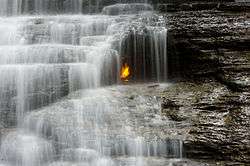Eternal Flame Falls
| Eternal Flame Falls | |
|---|---|
|
The natural gas-fueled "eternal flame" below the falls in early spring, 2009. | |
| Location |
Chestnut Ridge Park Erie County, New York |
| Coordinates | 42°42.1059′0″N 78°45.1025′0″W / 42.70177°N 78.75171°WCoordinates: 42°42.1059′0″N 78°45.1025′0″W / 42.70177°N 78.75171°W |
| Type | Cascade |
| Total height | 30 feet (9.1 m)[1] |
| Watercourse | Shale Creek, tributary to Eighteen Mile Creek |
The Eternal Flame Falls is a small waterfall located in the Shale Creek Preserve, a section of Chestnut Ridge Park in Western New York. A small grotto at the waterfall's base emits natural gas, which can be lit to produce a small flame. This flame is visible nearly year round, although it can be extinguished and must occasionally be re-lit.
The Eternal Flame Falls were featured in the book Secret Places by Bruce Kershner.
Recent developments
Once considered an "obscure" attraction in the region, recent media attention and improvements to the access trail have led to an increased number of visitors in recent years.[2] The increased popularity of the falls has led to some negative impacts, such as an increase in litter, vandalism, pollution, and impacts on the surrounding terrain by tourists,[1] but also fueled a successful public protest against a plan to clear a nearby forested area to install a disc golf course in 2012.[3][4]
In 2014, it was announced that the Eternal Flame Falls were filmed to be featured in an as-yet unnamed Travel Channel series hosted by Tory Belleci.[5]
Composition and source of gas
Geologists from Indiana University Bloomington and Italy's National Institute of Geophysics and Volcanology studied Eternal Flame Falls in 2013 in an effort to better understand how natural gas emitted from naturally occurring hydrocarbon seeps contribute to greenhouse gases in the atmosphere. They found that the 'macro seep' at Eternal Flame Falls had higher concentrations of ethane and propane (about 35%) than other known natural gas seeps, which typically contain a greater proportion of methane.[6] They estimated that the seep at the falls emits approximately one kilogram (2.2 lb) of methane per day.[7]
The researchers also noted the presence of numerous other 'micro seeps' in the area of the falls. By comparing the gas emitted by these seeps with gas from wells in the area, they determined that the gasses originate from Rhinestreet Shale approximately 400 meters (1,300 ft) below the surface. Tectonic activity likely opened faults in the shale, allowing the gas to reach the surface.[6]
According to one geologist involved in the 2013 study, the seep's apparent source could provide evidence for a previously unknown geologic mechanism by which natural gas is produced within shale. Typically, shale must be hot (around 100 °C [212 °F]) for its carbon structures to break down and form smaller natural gas molecules. However, the shale from which Eternal Flame Falls draws its gas is much cooler, in addition to being younger and shallower than typical gas-bearing shale. This may indicate that additional, as yet undemonstrated, processes can contribute to the creation of natural gas in shale; one possibility is that a catalyst capable of breaking down shale in cooler conditions is present.[8]
Images
See also
References
- 1 2 Conheady, Matt. "Eternal Flame Falls, Orchard Park – Waterfall Photos, Maps, Information". Nyfalls.com. Retrieved January 21, 2015.
- ↑ Cernavskis, Andra (July 10, 2014). "Eternal Flame draws crowds to Orchard Park". The Buffalo News. Retrieved January 21, 2015.
- ↑ "Eternal Flame Falls: Nature Burning Brightly". WGRZ.com. March 21, 2012. Retrieved January 21, 2015.
- ↑ Spencer, Naomi (January 26, 2012). "Discs cease flying near Eternal Flame Falls". Orchard Park Bee. Retrieved January 24, 2015.
- ↑ Colmerauer, Catherine (August 21, 2014). "Travel Channel to highlight eternal flame in new series". Orchard Park Bee. Retrieved April 11, 2015.
- 1 2 "Geologists study mystery of 'eternal flames'". IU News Room: Indiana University. May 9, 2013. Retrieved January 21, 2015.
- ↑ Etiopea, Giuseppe; Drobniakc, Agnieszka; Schimmelmannd, Arndt (May 2013). "Natural seepage of shale gas and the origin of 'eternal flames' in the Northern Appalachian Basin, USA". Marine and Petroleum Geology. 43: 178–186. doi:10.1016/j.marpetgeo.2013.02.009. Retrieved 21 January 2015.
- ↑ Main, Douglas (May 10, 2013). "World's 'Most Beautiful' Eternal Flame Reveals New Gas Source". Livescience.com. Retrieved January 25, 2015.

